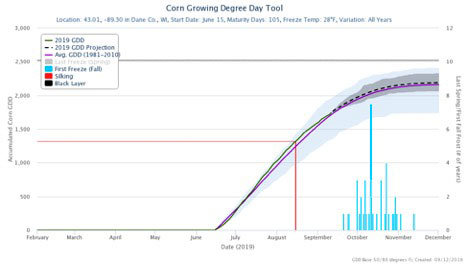
Take control. That’s a message I echoed in a recent webinar to dairy forage growers. By this statement, I mean get out, scout your fields with your agronomist and assess your corn’s current growth stage. This year’s corn crop across the U.S. is garnering good to excellent ratings, per recent USDA crop reports. However, a better rated crop doesn’t guarantee the standing crop makes it to the finish line for silage or high-moisture corn, let alone black layer.
For those farming in the High Plains, South, and West, you’re in a substantially better position than many in the Midwest, Northeast, and Canadian regions.
This year has been different than years past due to a jet stream pattern that brought cold and wet weather for many to start the growing season. Even corn planted on time didn’t get started for weeks or months and may be in a similar growth stage relative to later planted corn. Now, many cornfields in the northern U.S. and Canada are at risk of a killing frost prior to the crop reaching desired maturity. This isn’t cause for panic, but rather an opportunity to project your frost risk and take steps to mitigate and optimize the harvest in 2019.
So back to the initial point, take control by assessing the potential frost risk for your crop. Do this using the following steps:
- Work with your agronomist to scout and determine your current crop maturity.
- Determine the growing degree days (GDD) needed to bring your crop from current maturity to desired maturity.
a. Typically, early R5 for silage or closer to R6 for high-moisture shelled corn (HMSC).
b. For example, for a crop to move from dough stage to R5 (1/2 milkline), roughly 570 GDD are necessary. - Use readily available climate and GDD online tools to project how many GDD are left in the season.
The end of season is defined as the average historic frost date for your region.
To demonstrate the risk assessment, consider this case for my home county with full-season corn (105 days) planted in mid-June and Steps 1 through 3 outlined above:
- As of September 11, 1,745 GDD had accumulated for Dane County, Wis., since June 15 (Figure 1).
a. So, corn is at dough stage. - To mature from dough to 1/2 milk-layer (R5), roughly 570 GDD are necessary. Add 570 to 1,745, and recognize corn is ready to harvest for silage at around 2,315 GDD.
- Use the GDD tool (Figure 1) to forecast when an additional 570 GDD (after September 11) are accumulated, or 2,315 total GDD since June 15 occurs. Look for where the GDD projection curve reaches ~ 2,315 GDD.
a. We recognize that this corn will likely not achieve 2,315 GDD until late October at the earliest, thus is at substantial risk for frost kill.
b. Now we can be proactive with this in mind.








